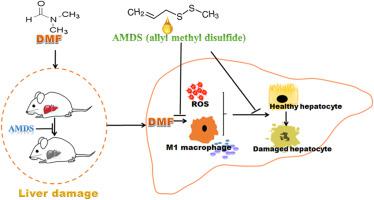Food and Chemical Toxicology ( IF 3.9 ) Pub Date : 2023-11-21 , DOI: 10.1016/j.fct.2023.114198 Long-Xia Li 1 , Lin Wang 1 , Shuo Wang 2 , Xiu-Ning Zhang 1 , Hong Liu 1 , Yan-Jing Zhang 1 , Chuan-Tao Wu 3 , Cui-Li Zhang 1 , Tao Zeng 1

|
N,N-dimethylformamide (DMF), a widely consumed industrial solvent with persistent characteristics, can induce occupational liver damage and pose threats to the general population due to the enormous DMF-containing industrial efflux and emission from indoor facilities. This study was performed to explore the roles of allyl methyl disulfide (AMDS) in liver damage induced by DMF and the underlying mechanisms. AMDS was found to effectively suppress the elevation in the liver weight/body weight ratio and serum aminotransferase activities, and reduce the mortality of mice induced by DMF. In addition, AMDS abrogated DMF-elicited increases in malondialdehyde (MDA) and 4-hydroxynonenal (4-HNE) levels and decreases in glutathione (GSH) levels in mouse livers. The increase in macrophage number, mRNA expression of M1 macrophage biomarkers, and protein expression of key components in the NF-κB pathway and NLRP3 inflammasome induced by DMF exposure were all suppressed by AMDS in mouse livers. Furthermore, AMDS inhibited DMF-induced cell damage and NF-κB activation in cocultured AML12 hepatocytes and J774A.1 macrophages. However, AMDS per se did not significantly affect the protein level and activity of CYP2E1. Collectively, these results demonstrate that AMDS effectively ameliorates DMF-induced acute liver damage possibly by suppressing oxidative stress and inactivating the NF-κB pathway and NLRP3 inflammasome.
中文翻译:

烯丙基甲基二硫 (AMDS) 通过抑制氧化应激和 NLRP3 炎性体激活来预防 N,N-二甲基甲酰胺诱导的肝损伤
N,N-二甲基甲酰胺(DMF)是一种广泛使用的具有持久性特征的工业溶剂,由于含有大量DMF的工业外排和室内设施的排放,可引起职业性肝损伤,并对普通人群构成威胁。本研究旨在探讨烯丙基甲基二硫醚(AMDS)在DMF诱导的肝损伤中的作用及其潜在机制。 AMDS被发现能有效抑制肝脏重量/体重比和血清转氨酶活性的升高,并降低DMF引起的小鼠死亡率。此外,AMDS 消除了 DMF 引起的小鼠肝脏中丙二醛 (MDA) 和 4-羟基壬烯醛 (4-HNE) 水平的增加以及谷胱甘肽 (GSH) 水平的降低。在小鼠肝脏中,DMF 暴露诱导的巨噬细胞数量增加、M1 巨噬细胞生物标志物 mRNA 表达以及 NF-κB 通路和 NLRP3 炎症小体中关键成分的蛋白表达均被 AMDS 抑制。此外,AMDS 抑制共培养的 AML12 肝细胞和 J774A.1 巨噬细胞中 DMF 诱导的细胞损伤和 NF-κB 活化。然而,AMDS本身并没有显着影响CYP2E1的蛋白水平和活性。总的来说,这些结果表明 AMDS 可能通过抑制氧化应激和灭活 NF-κB 通路和 NLRP3 炎性体来有效改善 DMF 诱导的急性肝损伤。






























 京公网安备 11010802027423号
京公网安备 11010802027423号